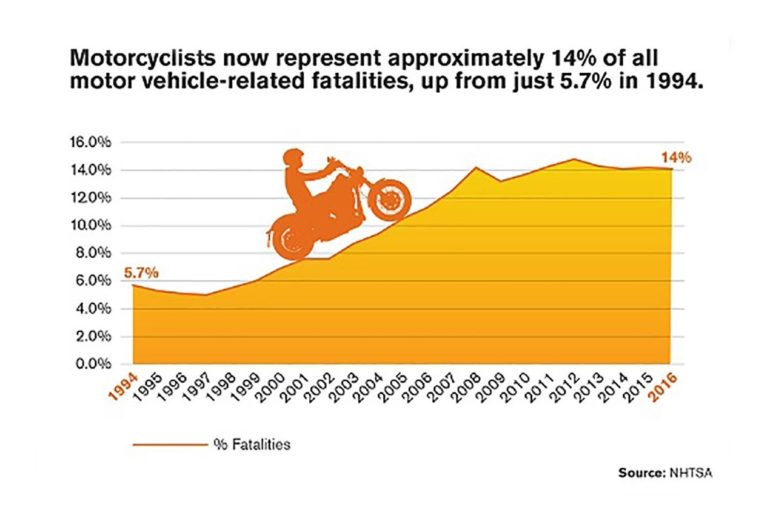Every year the Governors Highway Safety Association (GHSA) releases data about motorcycle fatalities in the United States. The results are never that surprising, and despite some fluctuations year-to-year, the basic takeaways are always the same.
Motorcyclists are way more likely to die (28x more likely per mile traveled) than automobile drivers and passengers; fatal motorcycle crashes are more likely to involve alcohol than other vehicle fatalities (25% vs. 21% for passenger cars); and motorcycle fatalities closely correlate to new motorcycle sales.
The figures are of course important, but reporting the results is an exercise in playing a broken record, over and over again. Except for one statistic that caught our eye this year: motorcycle fatalities as a percentage of overall vehicle fatalities.
In 1997, motorcycles accounted for just over 5% of all vehicle fatalities in the United States. A decade later, that percentage has grown almost three-fold, with motorcycles accounting for 14% of vehicle fatalities.
While some of this growth can be attributed to motorcycles becoming more dangerous to ride (a curious notion, in its own right), a healthy portion of that percentage growth is because of automobiles becoming more safe.
As we can see from the GHSA’s data, the overall number of vehicle fatalities in the United States has been on a massive nosedive since 2007. During the same time period, motorcycle fatalities have been relatively flat – thanks largely to the recession killing new motorcycle sales.
If we look at the chart below though, we can see the rise of motorcycles are a percentage of the total vehicle population.
Simply put, motorcycles are slowly becoming a larger portion of the deaths we see on the roadway – a trend that seems out of step with the number of miles being ridden, and the number of motorcycles registered for use on the street.
Like I said before, some of this growth is because motorcycle fatalities have increased over the years. In fact, motorcycle fatalities have more than doubled since 1997 (2.4x), but that is only part of the equation…and before you ask, motorcycles were only up 1.4x over the same time period.
So what gives? For starters, automobiles have also gotten safer in the past 10 years. Seatbelts, anti-locking brakes, traction control, stability control, crumple zones, adaptive cruise control, predictive braking, etc. – the list of automobile safety innovations goes on.
Meanwhile, the largest motorcycle sellers in the USA (Harley-Davidson, Honda, & Yamaha) often only offer ABS as an option for their street models.
The trends don’t quite line up, which is interesting, and I honestly can’t reconcile that notion, but on a more macro scale, we can see where these trends are headed.
As we look into our crystal ball, and predict the future of transportation, we can see an ever-changing landscapefor our motor vehicles. Automobiles are about to become radically more safe, as they prepare to rid themselves of their most dangerous attribute: the driver.
Autonomous vehicles, despite what current headlines might say, are set to make cars dramatically more safe, and from that we can expect vehicle fatalities in the United States to take another massive drop.
Some of this added safety will benefit motorcyclists, and likely have a downward effect on the number of yearly motorcycle fatalities. However, that effect will only be so large.
Fatal motorcycle crashes more often than not don’t involve another vehicle, which is to say that motorcycle crashes are more likely to be the motorcyclist’s fault, and not the cause of another motorist – say, an inattentive driver.
This leaves motorcycles in a precarious state, and over a large enough time period, it is not unreasonable to think that motorcycling’s measly ~5,000 fatalities per year could account for the lion’s share of vehicle fatalities, which doesn’t bode well for the future of our sport.
When the majority of vehicle fatalities can be attributed to “murdercycles” what expectations do we see from our local, state, and federal governments? To say it another way, do you expect our lawmakers to encourage or discourage the practice of riding a motorcycle?
This is perhaps the biggest question that the motorcycle industry faces for its future existence; and also one we are least prepared to tackle.
While we focus on sales that are spinning out of control, whether or not Brand X is coming out with the latest and greatest bike in Segment Y, all of it is moot if it is built on a foundation that cannot sustain motorcycling itself.
Motorcycles already suffer from a perception problem in the United States. They are dangerous machines for organ donors (the math actually supports this), and they are ridden by social outliers and outlaws (take a look on TV to see how motorcyclists are portrayed).
As motorcycles continue to rise as the societal outliers, especially when it comes to vehicle fatality figures, we further open ourselves up to a legal whack-a-mole, all in the name of safety.
To boil down an overused biological theory, motorcycling will either adapt or die. I do know one thing though: acting like the problem resides elsewhere is clearly not working.
Source: GHSA






